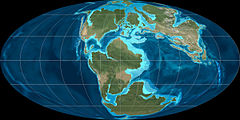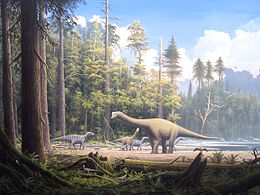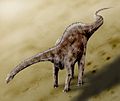- Jurassic
-
Jurassic Period
199.6–145.5 million years ago

Mean atmospheric O2 content over period duration ca. 26 Vol %[1]
(130 % of modern level)Mean atmospheric CO2 content over period duration ca. 1950 ppm[2]
(7 times pre-industrial level)Mean surface temperature over period duration ca. 16.5 °C[3]
(3 °C above modern level)The Jurassic is a geologic period and system that extends from about 199.6± 0.6 Mya (million years ago) to 145.5± 4 Mya, that is, from the end of the Triassic to the beginning of the Cretaceous. The Jurassic constitutes the middle period of the Mesozoic era, also known as the age of reptiles. The start of the period is marked by the major Triassic–Jurassic extinction event. However, the end of the Jurassic period did not witness any major extinction event. The start and end of the period are defined by carefully selected locations; the uncertainty in dating arises from trying to date these horizons.
The chronostratigraphic term "Jurassic" is directly linked to the Jura Mountains. Alexander von Humboldt recognized the mainly limestone dominated mountain range of the Jura Mountains as a separate formation that was not at the time included in the established stratigraphic system defined by Abraham Gottlob Werner and named it “Jurakalk” in 1795.[4][5][6] The name “Jura” is derived from the Celtic root “jor”, which was Latinised into “juria”, meaning forest (i.e. “Jura” is forest mountains).[4][5][7]
By the beginning of the Jurassic, the supercontinent Pangaea had rifted into two landmasses, Laurasia to the north and Gondwana to the south. This created more coastlines and caused a change in global climate from hot and dry to warm and humid, and many of the arid deserts of the Triassic were replaced by lush rainforests. The dinosaurs continued to dominate the land, and reached their peak in this period as they diversified into a wide variety of groups, ranging from the carnivorous theropods to the massive, herbivorous sauropods. Marine reptiles such as ichthyosaurs and plesiosaurs ruled the oceans, while pterosaurs, flying reptiles and the first airborne vertebrates, took to the sky.
Contents
Divisions
The Jurassic period is divided into Early Jurassic, Middle, and Late Jurassic epochs. The Jurassic System, in stratigraphy, is divided into Lower Jurassic, Middle, and Upper Jurassic series of rock formations, also known as Lias, Dogger and Malm in Europe.[8] The separation of the term Jurassic into three sections goes back to Leopold von Buch (* 1774, † 1853).[6] The faunal stages from youngest to oldest are:
Upper/Late Jurassic Tithonian (150.8 ± 4.0 – 145.5 ± 4.0 Mya) Kimmeridgian (155.7 ± 4.0 – 150.8 ± 4.0 Mya) Oxfordian (161.2 ± 4.0 – 155.7 ± 4.0 Mya) Middle Jurassic Callovian (164.7 ± 4.0 – 161.2 ± 4.0 Mya) Bathonian (167.7 ± 3.5 – 164.7 ± 4.0 Mya) Bajocian (171.6 ± 3.0 – 167.7 ± 3.5 Mya) Aalenian (175.6 ± 2.0 – 171.6 ± 3.0 Mya) Lower/Early Jurassic Toarcian (183.0 ± 1.5 – 175.6 ± 2.0 Mya) Pliensbachian (189.6 ± 1.5 – 183.0 ± 1.5 Mya) Sinemurian (196.5 ± 1.0 – 189.6 ± 1.5 Mya) Hettangian (199.6 ± 0.6 – 196.5 ± 1.0 Mya)  Large dinosaurs roamed forests of similarly large conifers during the Jurassic period.
Large dinosaurs roamed forests of similarly large conifers during the Jurassic period.
Paleogeography and tectonics
During the early Jurassic period, the supercontinent Pangaea broke up into the northern supercontinent Laurasia and the southern supercontinent Gondwana; the Gulf of Mexico opened in the new rift between North America and what is now Mexico's Yucatan Peninsula. The Jurassic North Atlantic Ocean was relatively narrow, while the South Atlantic did not open until the following Cretaceous period, when Gondwana itself rifted apart.[9] The Tethys Sea closed, and the Neotethys basin appeared. Climates were warm, with no evidence of glaciation. As in the Triassic, there was apparently no land near either pole, and no extensive ice caps existed.
The Jurassic geological record is good in western Europe, where extensive marine sequences indicate a time when much of the continent was submerged under shallow tropical seas; famous locales include the Jurassic Coast World Heritage Site and the renowned late Jurassic lagerstätten of Holzmaden and Solnhofen.[10] In contrast, the North American Jurassic record is the poorest of the Mesozoic, with few outcrops at the surface.[11] Though the epicontinental Sundance Sea left marine deposits in parts of the northern plains of the United States and Canada during the late Jurassic, most exposed sediments from this period are continental, such as the alluvial deposits of the Morrison Formation.
The Jurassic was a time of calcite sea geochemistry in which low-magnesium calcite was the primary inorganic marine precipitate of calcium carbonate. Carbonate hardgrounds were thus very common, along with calcitic ooids, calcitic cements, and invertebrate faunas with dominantly calcitic skeletons (Stanley and Hardie, 1998, 1999).
The first of several massive batholiths were emplaced in the northern Cordillera beginning in the mid-Jurassic, marking the Nevadan orogeny.[12] Important Jurassic exposures are also found in Russia, India, South America, Japan, Australasia and the United Kingdom.
In Africa, Early Jurassic strata are distributed in a similar fashion to Late Triassic beds, with more common outcrops in the south and less common fossil beds which are predominated by tracks to the north.[13] As the Jurassic proceeded, larger and more iconic groups of dinosaurs like sauropods and ornithopods proliferated in Africa.[13] Middle Jurassic strata are neither well represented nor well studied in Africa.[13] Late Jurassic strata are also poorly represented apart from the spectacular Tendeguru fauna in Tanzania.[13] The Late Jurassic life of Tendeguru is very similar to that found in western North America's Morrison Formation.[13]
-
Jurassic limestones and marls (the Matmor Formation) in southern Israel.
-
The late Jurassic Morrison Formation in Colorado is one of the most fertile sources of dinosaur fossils in North America.
-
Gigandipus, a dinosaur footprint in the Lower Jurassic Moenave Formation at the St. George Dinosaur Discovery Site at Johnson Farm, southwestern Utah.
-
The Permian through Jurassic stratigraphy of the Colorado Plateau area of southeastern Utah.
Fauna
Aquatic and marine
During the Jurassic period, the primary vertebrates living in the seas were fish and marine reptiles. The latter include ichthyosaurs who were at the peak of their diversity, plesiosaurs, pliosaurs, and marine crocodiles of the families Teleosauridae and Metriorhynchidae.[14]
In the invertebrate world, several new groups appeared, including rudists (a reef-forming variety of bivalves) and belemnites. The Jurassic also had diverse encrusting and boring (sclerobiont) communities, and it saw a significant rise in the bioerosion of carbonate shells and hardgrounds. Especially common is the ichnogenus (trace fossil) Gastrochaenolites.[15]
During the Jurassic period about four or five of the twelve clades of planktonic organisms that exist in the fossil record either experienced a massive evolutionary radiation or appeared for the first time.[8]
-
An over 10 metres long Liopleurodon (right) harassing an even larger Leedsichthys in a Jurassic sea.
-
Ichthyosaurus from lower (early) Jurassic slates in southern Germany featured a dolphin-like body shape.
-
Plesiosaurs like Muraenosaurus roamed Jurassic oceans.
-
Gastropod and attached mytilid bivalves on a Jurassic limestone bedding plane in southern Israel.
Terrestrial
On land, large archosaurian reptiles remained dominant. The Jurassic was a golden age for the large herbivorous dinosaurs known as the sauropods—Camarasaurus, Apatosaurus, Diplodocus, Brachiosaurus, and many others—that roamed the land late in the period; their mainstays were either the prairies of ferns, palm-like cycads and bennettitales, or the higher coniferous growth, according to their adaptations. They were preyed upon by large theropods as for example Ceratosaurus, Megalosaurus, Torvosaurus and Allosaurus. All these belong to the 'lizard hipped' or saurischian branch of the dinosaurs.[16] During the Late Jurassic, the first birds, like Archaeopteryx, evolved from small coelurosaurian dinosaurs. Ornithischian dinosaurs were less predominant than saurischian dinosaurs, although some like stegosaurs and small ornithopods played important roles as small and medium-to-large (but not sauropod-sized) herbivores. In the air, pterosaurs were common; they ruled the skies, filling many ecological roles now taken by birds.[17] Within the undergrowth were various types of early mammals, as well as tritylodont mammal-like reptiles, lizard-like sphenodonts, and early lissamphibians.
The rest of the Lissamphibia evolved in this period, introducing the first salamanders and caecilians.[18]
-
Diplodocus, reaching lengths over 30 m, was a common sauropod during the late Jurassic.
-
Allosaurus was one of the largest land predators during the Jurassic.
-
Stegosaurus is one of the most recognizable genera of dinosaurs and lived during the mid to late Jurassic.
-
Archaeopteryx appeared in the Late Jurassic, and was a feathered dinosaur connected with the evolution of birds.
Flora
The arid, continental conditions characteristic of the Triassic steadily eased during the Jurassic period, especially at higher latitudes; the warm, humid climate allowed lush jungles to cover much of the landscape.[19] Gymnosperms were relatively diverse during the Jurassic period.[8] The Conifers in particular dominated the flora, as during the Triassic; they were the most diverse group and constituted the majority of large trees. Extant conifer families that flourished during the Jurassic included the Araucariaceae, Cephalotaxaceae, Pinaceae, Podocarpaceae, Taxaceae and Taxodiaceae.[20] The extinct Mesozoic conifer family Cheirolepidiaceae dominated low latitude vegetation, as did the shrubby Bennettitales.[21] Cycads were also common, as were ginkgos and Dicksoniaceous tree ferns in the forest.[8] Smaller ferns were probably the dominant undergrowth. Caytoniaceous seed ferns were another group of important plants during this time and are thought to have been shrub to small-tree sized.[22] Ginkgo plants were particularly common in the mid- to high northern latitudes.[8] In the Southern Hemisphere, podocarps were especially successful, while Ginkgos and Czekanowskiales were rare.[19][21]
In the oceans modern coralline algae appeared for the first time.[8]
Notes
- ^ Image:Sauerstoffgehalt-1000mj.svg
- ^ Image:Phanerozoic Carbon Dioxide.png
- ^ Image:All palaeotemps.png
- ^ a b Hölder, H. 1964. Jura — Handbuch der stratigraphischen Geologie, IV. Enke-Verlag, 603 pp., 158 figs, 43 tabs; Stuttgart
- ^ a b Arkell, W.J. 1956. Jurassic Geology of the World. Oliver & Boyd, 806 pp.; Edinburgh und London.
- ^ a b Pieńkowski, G.; Schudack, M.E.; Bosák, P.; Enay, R.; Feldman-Olszewska, A.; Golonka, J.; Gutowski, J.; Herngreen, G.F.W.; Jordan, P.; Krobicki, M.; Lathuiliere, B.; Leinfelder, R.R.; Michalík, J.; Mönnig, E.; Noe-Nygaard, N.; Pálfy, J.; Pint, A.; Rasser, M.W.; Reisdorf, A.G.; Schmid, D.U.; Schweigert, G.; Surlyk, F.; Wetzel, A. & Theo E. Wong, T.E. 2008. Jurassic. In: McCann, T. (ed.): The Geology of Central Europe. Volume 2: Mesozoic and Cenozoic, Geological Society, pp.: 823-922; London.
- ^ Rollier, L. 1903. Das Schweizerische Juragebirge. Sonderabdruck aus dem Geographischen Lexikon der Schweiz, Verlag von Gebr. Attinger, 39 pp; Neuenburg
- ^ a b c d e f Kazlev, M. Alan (2002) Palaeos website Accessed July. 22, 2008
- ^ Late Jurassic
- ^ Jurassic Period
- ^ map
- ^ Monroe and Wicander, 607.
- ^ a b c d e Jacobs, Louis, L. (1997). "African Dinosaurs". Encyclopedia of Dinosaurs. Edited by Phillip J. Currie and Kevin Padian. Academic Press. p. 2-4.
- ^ Motani, R. (2000), Rulers of the Jurassic Seas, Scientific American vol.283, no. 6
- ^ Taylor, P.D. and Wilson, M.A., 2003. Palaeoecology and evolution of marine hard substrate communities. Earth-Science Reviews 62: 1-103
- ^ Haines, Tim (2000) Walking with Dinosaurs: A Natural History, New York: Dorling Kindersley Publishing, Inc.
- ^ Feduccia, A. (1996). The Origin and Evolution of Birds. Yale University Press, New Haven. ISBN 0-300-06460-8
- ^ Carroll, RL (1988), Vertebrate Paleontology and Evolution, WH Freeman & Co.
- ^ a b Haines, 2000.
- ^ Behrensmeyer et al., 1992, 349.
- ^ a b Behrensmeyer et al., 1992, 352
- ^ Behrensmeyer et al., 1992, 353
References
- Behrensmeyer, Anna K., Damuth, J.D., DiMichele, W.A., Potts, R., Sues, H.D. & Wing, S.L. (eds.) (1992), Terrestrial Ecosystems through Time: the Evolutionary Paleoecology of Terrestrial Plants and Animals, University of Chicago Press, Chicago and London, ISBN 0-226-04154-9 (cloth), ISBN 0-226-04155-7 (paper).
- Haines, Tim (2000) Walking with Dinosaurs: A Natural History, New York: Dorling Kindersley Publishing, Inc., p. 65. ISBN 0-563-38449-2.
- Kazlev, M. Alan (2002) Palaeos website Accessed Jan. 8, 2006.
- Mader, Sylvia (2004) Biology, eighth edition.
- Monroe, James S., and Reed Wicander. (1997) The Changing Earth: Exploring Geology and Evolution, 2nd ed. Belmont: West Publishing Company, 1997. ISBN 0-314-09577-2.
- Ogg, Jim; June, 2004, Overview of Global Boundary Stratotype Sections and Points (GSSP's), International Commission on Stratigraphy, pp. 17
- Stanley, S.M. and Hardie, L.A. (1998). "Secular oscillations in the carbonate mineralogy of reef-building and sediment-producing organisms driven by tectonically forced shifts in seawater chemistry". Palaeogeography, Palaeoclimatology, Palaeoecology 144: 3–19.
- Stanley, S.M. and Hardie, L.A. (1999). "Hypercalcification; paleontology links plate tectonics and geochemistry to sedimentology". GSA Today 9: 1–7.
- Taylor, P.D. and Wilson, M.A., 2003. Palaeoecology and evolution of marine hard substrate communities. Earth-Science Reviews 62: 1–103. [1].
External links
Listen to this article (info/dl)
This audio file was created from a revision of Jurassic dated 2010-08-19, and does not reflect subsequent edits to the article. (Audio help)More spoken articles- Examples of Jurassic Fossils
- Palaeos.com
- Jurassic fossils in Harbury, Warwickshire
- Jurassic Microfossils: 65+ images of Foraminifera
Jurassic Period Lower/Early Jurassic Middle Jurassic Upper/Late Jurassic Hettangian | Sinemurian
Pliensbachian | ToarcianAalenian | Bajocian
Bathonian | CallovianOxfordian | Kimmeridgian
TithonianPreceded by Proterozoic Eon 542 Ma - Phanerozoic Eon - Present 542 Ma - Paleozoic Era - 251 Ma 251 Ma - Mesozoic Era - 65 Ma 65 Ma - Cenozoic Era - Present Cambrian Ordovician Silurian Devonian Carboniferous Permian Triassic Jurassic Cretaceous Paleogene Neogene Quaternary Categories:- Periods with timeline in infobox
- Jurassic
-
Wikimedia Foundation. 2010.












